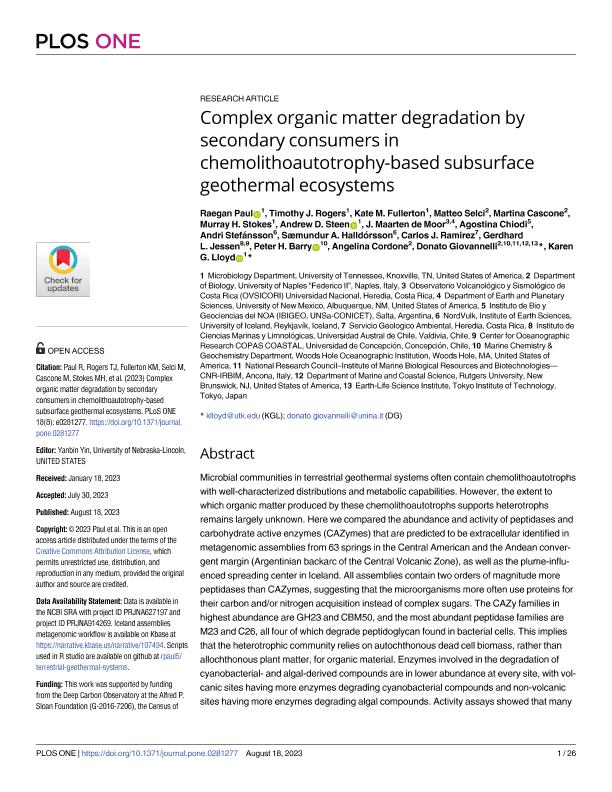Artículo
Complex organic matter degradation by secondary consumers in chemolithoautotrophy-based subsurface geothermal ecosystems
Paul, Raegan; Rogers, Timothy J.; Fullerton, Kate M.; Selci, Matteo; Cascone, Martina; Stokes, Murray H.; Steen, Andrew D.; de Moor, J. Maarten; Chiodi, Agostina Laura ; Stefánsson, Andri; Halldórsson, Sæmundur A.; Ramirez, Carlos J.; Jessen, Gerdhard L.; Barry, Peter H.; Cordone, Angelina; Giovannelli, Donato; Lloyd, Karen G.
; Stefánsson, Andri; Halldórsson, Sæmundur A.; Ramirez, Carlos J.; Jessen, Gerdhard L.; Barry, Peter H.; Cordone, Angelina; Giovannelli, Donato; Lloyd, Karen G.
 ; Stefánsson, Andri; Halldórsson, Sæmundur A.; Ramirez, Carlos J.; Jessen, Gerdhard L.; Barry, Peter H.; Cordone, Angelina; Giovannelli, Donato; Lloyd, Karen G.
; Stefánsson, Andri; Halldórsson, Sæmundur A.; Ramirez, Carlos J.; Jessen, Gerdhard L.; Barry, Peter H.; Cordone, Angelina; Giovannelli, Donato; Lloyd, Karen G.
Fecha de publicación:
08/2023
Editorial:
Public Library of Science
Revista:
Plos One
ISSN:
1932-6203
Idioma:
Inglés
Tipo de recurso:
Artículo publicado
Clasificación temática:
Resumen
Microbial communities in terrestrial geothermal systems often contain chemolithoautotrophs with well-characterized distributions and metabolic capabilities. However, the extent to which organic matter produced by these chemolithoautotrophs supports heterotrophs remains largely unknown. Here we compared the abundance and activity of peptidases and carbohydrate active enzymes (CAZymes) that are predicted to be extracellular identified in metagenomic assemblies from 63 springs in the Central American and the Andean convergent margin (Argentinian backarc of the Central Volcanic Zone), as well as the plume-influenced spreading center in Iceland. All assemblies contain two orders of magnitude more peptidases than CAZymes, suggesting that the microorganisms more often use proteins for their carbon and/or nitrogen acquisition instead of complex sugars. The CAZy families in highest abundance are GH23 and CBM50, and the most abundant peptidase families are M23 and C26, all four of which degrade peptidoglycan found in bacterial cells. This implies that the heterotrophic community relies on autochthonous dead cell biomass, rather than allochthonous plant matter, for organic material. Enzymes involved in the degradation of cyanobacterial- and algal-derived compounds are in lower abundance at every site, with volcanic sites having more enzymes degrading cyanobacterial compounds and non-volcanic sites having more enzymes degrading algal compounds. Activity assays showed that many of these enzyme classes are active in these samples. High temperature sites (> 80°C) had similar extracellular carbon-degrading enzymes regardless of their province, suggesting a less well-developed population of secondary consumers at these sites, possibly connected with the limited extent of the subsurface biosphere in these high temperature sites. We conclude that in < 80°C springs, chemolithoautotrophic production supports heterotrophs capable of degrading a wide range of organic compounds that do not vary by geological province, even though the taxonomic and respiratory repertoire of chemolithoautotrophs and heterotrophs differ greatly across these regions.
Palabras clave:
MICROBIAL COMMUNITIES
,
GEOTHERMAL FLUIDS
,
CONVERGENT MARGIN
,
CARBON BUDGET
Archivos asociados
Licencia
Identificadores
Colecciones
Articulos(IBIGEO)
Articulos de INST.DE BIO Y GEOCIENCIAS DEL NOA
Articulos de INST.DE BIO Y GEOCIENCIAS DEL NOA
Citación
Paul, Raegan; Rogers, Timothy J.; Fullerton, Kate M.; Selci, Matteo; Cascone, Martina; et al.; Complex organic matter degradation by secondary consumers in chemolithoautotrophy-based subsurface geothermal ecosystems; Public Library of Science; Plos One; 18; 8-2023; 1-26
Compartir
Altmétricas



